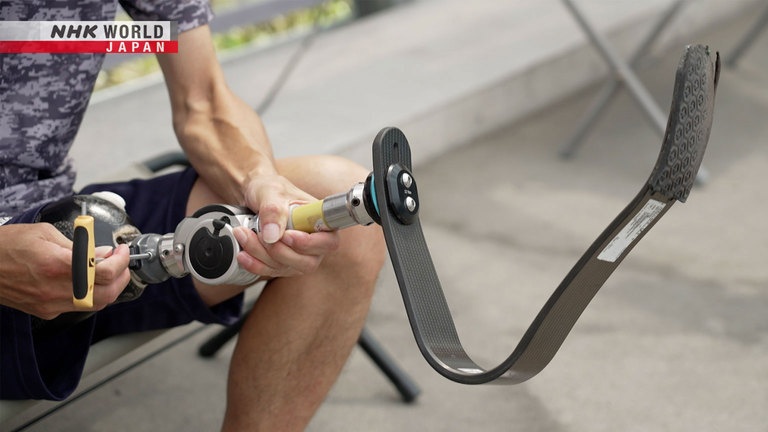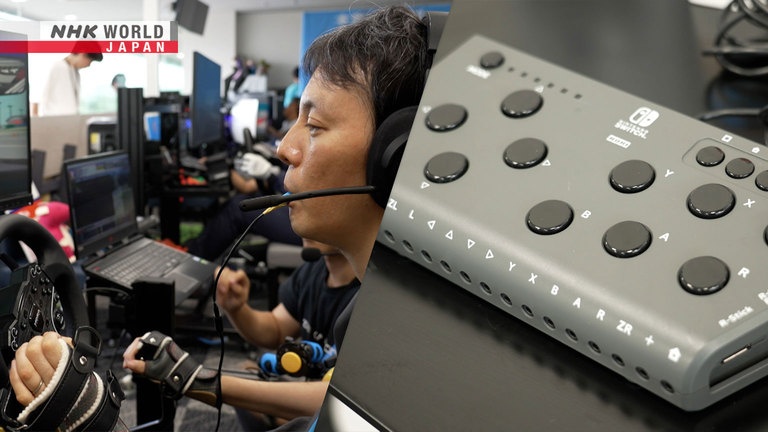Making Sports and Gaming More Accessible
[SPECIAL EDITION]
This series provides updates and new perspectives on selected stories from BIZ STREAM's signature "On-Site" reports.
From sports prosthetics to video game controller systems, this episode features companies creating innovative new products designed to make recreational activities accessible to as many people as possible.
*Subtitles and transcripts are available for video segments when viewed on our website.
Making Sports and Gaming More Accessible


Transcript
A new sports prosthesis designed to get more people running.
And a gaming device created for people with disabilities, that lets them enjoy playing video games.
Today's On-site Report features companies creating innovative new products,
designed to make sports and video games more accessible to people with disabilities.
Every month, a training and practice session for learning how to use running prosthetics is held at this track.
Because there's a major difference between standard artificial legs, that are made for walking...
and "blades" or prosthetics made specifically for running, it takes a lot of practice to get used to them.
The "Blade Library" first opened in 2017.
It rents out a variety of running prosthetics, in the hopes of giving as many people as possible access to them.
Users can try out any blade they want at the facility for about $7, which includes a custom fitting and adjustment from an expert.
They can also choose to rent them out for longer periods of time, so they can practice on their own.
When I tried running with a standard prosthetic, I often felt like I was going to fall.
So when I heard about these running blades, I wanted to come give them a try.
The "Blade Library" was created by Endo Ken.
He's designed and fabricated running blades for some of the world's top Paralympic sprinters.
I don't want people to give up on running, because they're missing a leg.
That's why I've decided to do this.
The facility's practice sessions are led by certified parasports instructors, who teach users proper running technique.
While it might look simple, learning to use them is very difficult.
Runners must learn how to properly shift their center of gravity, allowing the blade to release as much energy as possible,
as the prosthetic rebounds upwards after compression, propelling them forward.
I'm so happy my son has the opportunity to come here and learn how to use a blade.
Being able to rent one is also a huge help!
To date, more than 600 people have used the facilities.
Wanting to further promote the use of blade prosthetics, Endo began work on developing a more affordable, entry-level version in 2020.
To achieve this goal, he chose to use a more affordable type of carbon fiber,
and has come up with a new design that is just as durable, despite requiring fewer layers of material.
Endo hopes to have the new blades available for purchase in the spring of this year, and plans on selling them for about $750,
less than half the price of similar products currently on the market today.
I want to normalize the use of blades, so that people have the option of using different types of prosthetics,
just like when choosing which shoes to wear.
7 year-old Tachibana Shizuha recently began coming to the practice sessions.
She lost her leg last year, after being struck by a car while going on a walk with her family.
Shizuha began learning to run with a blade prosthetic, with the goal of participating with her classmates at her school's Sports Day in October.
I want to participate in the ball-rolling race, 50m dash,
class dance performance, and the ball toss.
I hope these can help as many children to run as possible.
My daughter is really enjoying herself.
We should give our children every opportunity that we can.
This gamer is competing in a racing event.
Teams are made up of three people, with each driver swapping out every 30 minutes.
The team that completes the most laps within the time limit wins.
Of the three teams, two are made up of people with disabilities.
Instead of standard controllers, they are using a variety of devices adapted to their own individual needs.
This racer uses a switch he controls with his mouth and an elbow button for shifting gears;
he uses his right hand for controlling speed.
The devices are connected to a piece of hardware called a flex controller,
which translates all their inputs, so they can be used with standard PC or console games.
Specializing in assistive technology, Shimada Shintaro's company co-developed the unique combination of hub and controller.
He first came up with the concept about 6 years ago, after visiting the home of a client,
who had a highly-customized gaming rig set up in his room.
Despite being severely disabled, he went to great lengths just to be albe to play games.
He had done a lot of research and even imported some components, so he could put together his own custom gaming setup.
That's when Shimada realized how important gaming can be for people with disabilities.
I felt we might be able to make a positive impact, if we applied all the technical know-how we had gained to gaming products.
Shimada's company then teamed up with a major gaming accessory maker to develop the hub controller.
The hub controller's biggest merit is that it can be used with various external devices,
meaning that it can be adapted to suit players with a wide range of disabilities.
After clearing testing, it was officially licensed by Nintendo,
and is now available for purchase in five different countries, including Japan.
One of its users is 29-year old Shirai Fuma.
He first began playing video games when he was just four years old,
but was forced to stop about five years ago, as the symptoms of his muscular dystrophy worsened.
Last year, however, Shirai decided to order a controller hub and a custom-made gaming set from Shimada's company.
He uses a joystick in his right hand, which still is has some degree of mobility.
Since he can only move the fingers on his left hand a few millimeters,
he uses micro switches, which only requires ten grams of force to press.
The highly-sensitive devices allow Shirai to deftly maneuver characters or vehicles while playing.
With a standard controller, I just couldn't play how I wanted, and had pretty much given up on video games.
So, I was really surprised to find out that there were customizable controllers,
that could make it possible for people with limited range of motion, like me, to play.
Shirai, you're in first place!
Gaming allows people from all over the world to compete against each other or join forces to reach a common goal as equals.
I want to contribute to a society where everyone can participate regardless of their physical condition.